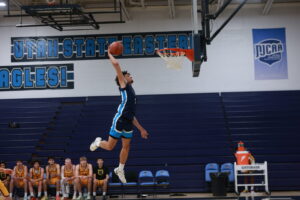Signing day: the intent is clear, if not beneficial
There is a theory that the very best high school football and basketball players would be better off not signing letters of intent.
They virtually all sign, though, primarily to end the aggravation of recruiting.
“The main thing,” said John Beam, a longtime coach at Oakland’s Skyline High School who is now an assistant at Laney College, also in Oakland, “is that it gets it over with for the players being recruited. And I think the coaches love it for the same reason. They’re all sweating bullets now, but after it’s done, they have time to breathe.”
This archived article was written by: staff
There is a theory that the very best high school football and basketball players would be better off not signing letters of intent.
They virtually all sign, though, primarily to end the aggravation of recruiting.
“The main thing,” said John Beam, a longtime coach at Oakland’s Skyline High School who is now an assistant at Laney College, also in Oakland, “is that it gets it over with for the players being recruited. And I think the coaches love it for the same reason. They’re all sweating bullets now, but after it’s done, they have time to breathe.”
In college football, the day of reckoning is Wednesday, the first day of the sport’s signing period. Who signs where is big news these days, thanks in large part to the Internet. Previews of signing day even exist, with Tennessee, Nebraska, Oklahoma, Michigan, Iowa and Georgia vying for No. 1 this season and USC again making a late rush to become the top recruiting class.
However, situations exist, such as the case of Kentucky basketball freshman Joe Crawford, in which the letter of intent inhibits the player’s mobility. Coaches with long-term contracts making tons of money may leave at any time, and schools can sign more players than they have scholarships. Yet teenage players are bound by their letter of intent.
Before blaming the NCAA for whatever shortcomings letters of intent have, it should be noted the NCAA has nothing to do with it. The letter of intent was started in 1964 by the Collegiate Commissioners Association, the folks who brought us the BCS. It is basically an agreement among virtually all Division I schools and conferences to abide by its rules for signing players.
The letter of intent says the player agrees to attend that school for one year and the school agrees to give the player an athletic scholarship for one year.
And it is binding.
Before the letter of intent was enacted, players could be recruited until the day they enrolled, leaving the coaches unsure of what they had and leaving players with an onslaught of recruiting pressure right up to their first college practice.
It did not work so nicely for Kentucky’s Crawford. By late December, he wanted to transfer, apparently for lack of playing time, even though, as a freshman, he was a sixth man on the nation’s No. 6 team. He seemed destined for Michigan State, but Kentucky refused to release him from his letter of intent, which is in effect through his entire freshman season.
Had he left without a release, Crawford would have lost an entire season of eligibility, and could have played only 11/2 seasons at his new school. So Crawford remained at Kentucky, with the option of transferring after the season.
On one hand, it might be worthwhile to discourage mobility of college players.
“You don’t want kids jumping all around,” Beam said. “You’re already seeing it in high schools and junior colleges.”
On the other hand, it seems unfair for the university to hold all the cards.
“It’s kind of a one-sided agreement,” City College of San Francisco football coach George Rush said.
Two years ago, Rush’s defensive star Chijioke Onyenegecha signed with Arizona State, primarily because




